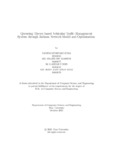Queueing theory based vehicular traffic management system through Jackson Network Model and Optimization
Abstract
Vehicular Traffic congestion is a colossal factor of concern in different parts around
the world, especially here in an overpopulated third world country such as Bangladesh.
Spontaneous urbanization and vehicle policies set by authorities have taken this is-
sue to the point close to intolerance for different class and occupation of people in
this part of the world. One of the other major reasons for this problem to spread-
out is the traditional traffic management system where service time for each traffic
signal are constant for any point in time of the day. With the rise in the num-
ber of vehicles, complexities and variations in arrival rate of vehicles in a specific
traffic signal for different days and different time of each day have nullified the efficiency of the traditional traffic signal and management system. A constant waiting
time-based traffic system cannot handle this uprising problem of complex traffic
congestion. As a solution, the proposed model uses a single-server Jackson queue-
ing network and optimization theory based approach to improve the current traffic
management system into an autonomous traffic management system. Now-a -days,
in the same traffic point the arrival rate of vehicle varies in different time of the
day and between weekdays and weekends. Firstly, the proposed model will make
a probabilistic assumption of the vehicle arrival rate of different point of time in
different important traffic points in a selected region. Arbitrary data within a given
range will be provided to the model for simulation purpose. Optimization theory,
quadratic optimization to be precise, will be used to make the assumptions and
results as effective and efficient as possible depending on our derived formula. Then
the proposed model will implement and simulate a complex traffic network based on
an open Jackson queueing network where users/customers can enter from and leave
to an external source of the network, and multiple queues are interconnected with
each other and operates independently. A comparative visualization and analysis of
the results derived from our model will also be provided in our report. Finally, the
model will compute and produce an efficient and autonomous traffic management
system, which will optimize and reduce the trac signal waiting time and service
time as much as possible based on the real-time situation.

